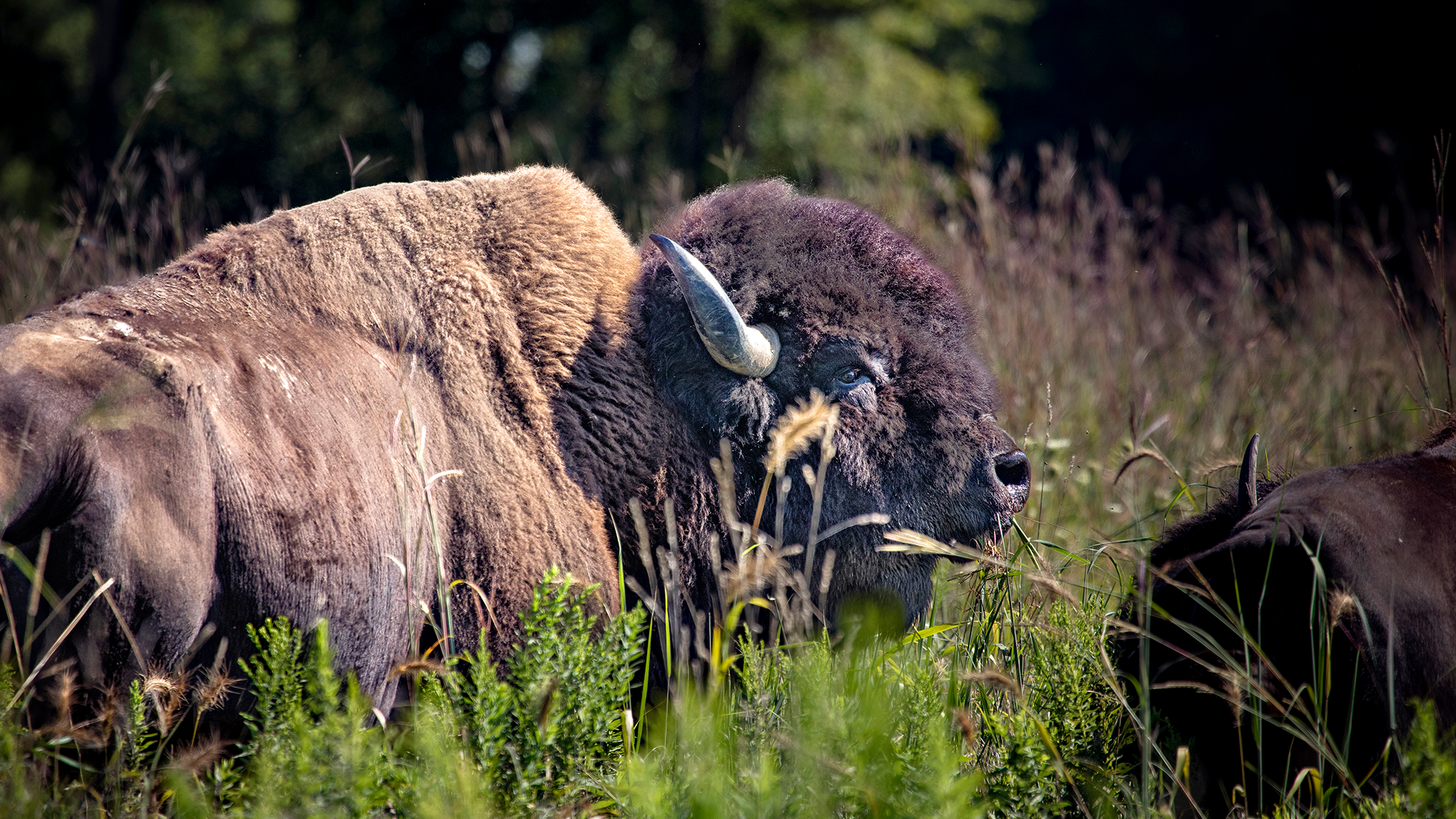
Bison
(Bison bison)
Bison FAQs
The Bison was officially recognized as the national mammal of the United States of America on May 9, 2016.
How big are bison?
Bison are the largest land mammal in the United States a male bison (bull) can weigh over 2000 lbs, female bison (cow) can weigh upwards of 1200 pounds, and a bison calf typically weigh 40 -50 pounds at birth. Male bison stand close to 6 feet tall at the shoulder and can be almost 11 feet from head to tail and females being just a little shorter.
What do bison eat?
90-98% of their diet consists of grasses and sedges. In particular bison have evolved consuming native warm season grasses. Specifically, Andropogon gerardii (Big Bluestem grass), Panicum virgatum (Switchgrass), Schizachyrium scoparium (Little Bluestem grass), and Sorghastrum nutans (Indian grass). Bison, who are related to cows, digest their food more efficiently than cows. This means that bison are able to extract the same amount of nutrients from less vegetation. Because of this increased efficiency bison also require less water than cattle.
Where do bison live?
Prior to European settlement, bison were present all across North America with their highest concentrations east of the Rocky Mountains all the way to the Appalachian Mountains in the east; and as far south as northern Mexico, up to upstate New York and the middle of Canada to the north. However, today, Yellowstone National Park, Fort Peck Indian Reservation in Montana, Henry Mountains and Book Cliffs in Utah, the Rocky Mountain National Wildlife Refuge in Colorado, and Delta Junction in Alaska are the few locations were free-ranging herds can be seen in the U.S.
Do all bison have antlers?
Bison do not have antlers. Rather they, like their cousin the cow, have horns. Both male and female bison have horns. You can even see on the youngest calf the beginnings of their horns. Bison horns have a bony core with a keratin (a fibrous protein also found in finger/toe nails and hair) sheath. Horns are not shed and they grow the entire life of the bison.
How many bison are there?
Prior to 1800 the number of bison present in North America, mostly in the US, ranged from 30 – 60 million individuals. During the period from 1830 to 1880, their numbers were reduced to only a few thousand. It has been estimated that 2 million were killed in 1870 alone. In 1872-73, on average, 5000 bison were killed every day (that’s 3,650,000 individuals)! In 1882, a single day hunt saw the killing of 10,000 bison, and by 1883, there were virtually no bison remaining in North America. In 1884, it was estimated that there were only about 325 bison remaining, just 25 in Yellowstone (the only location where bison have lived continuously since pre-settlement), in the United States. However, the story of bison isn’t over. Their story is one of resilience and by the mid-1990s there were ~25,000 bison in public and at least a quarter million bison in private herds all across the country.
What role does bison play in culture, especially Native American culture?
Bison are extremely important to all the Native American cultures. Because of this importance no part of the bison goes to waste. They did not simply see it as a source for meat. The entire body of the bison had value. Bones were used to make tools, knives, arrowheads, scrapers, toys, and fertilizer; buckskin was used for winter robes, clothes, tipi coverings, and bags; bison hair was used for pillows, rope, ornamaents, and headdresses; rawhide was used for containers, sheilds, drums, saddles, and shoes; the rumen was used for buckets, canteens, and to wrap meat, and horns were used for cups, spoons, toys, and in medicine. These are not exhaustive lists of the ways Native Americans used bison for everyday life.
When do bison give birth?
Bison typically give birth mid-April through June, although births have been known to occur in the autumn. When this occurs, the bison calf needs to make sure to gain enough weight or risk not making it through a harsh winter.
Do bison have any predators?
Because bison are so large they no longer have many natural predators other than humans. However, mountain lions, bears, and wolves are known to attack very young and old as well as any sick and injured bison.
